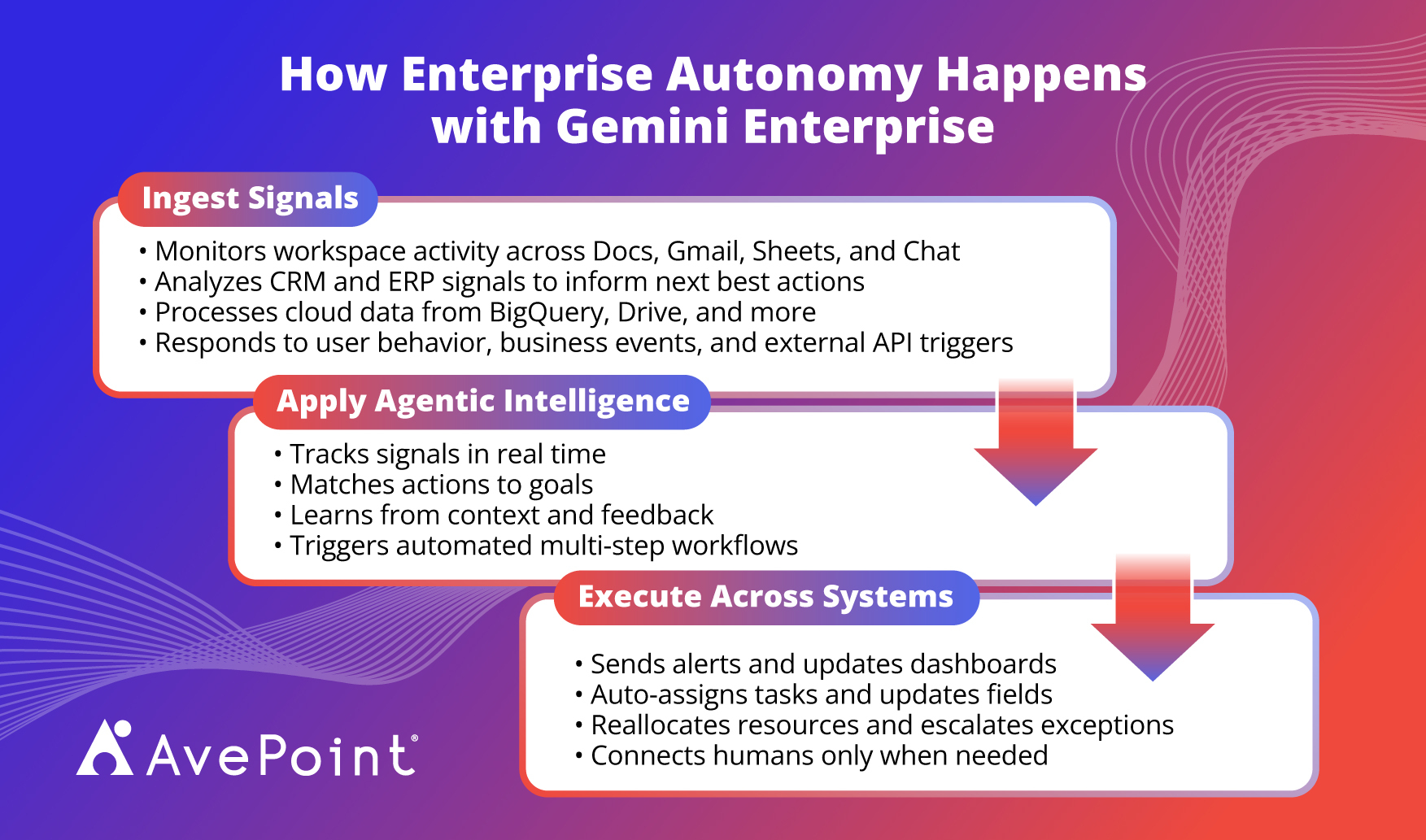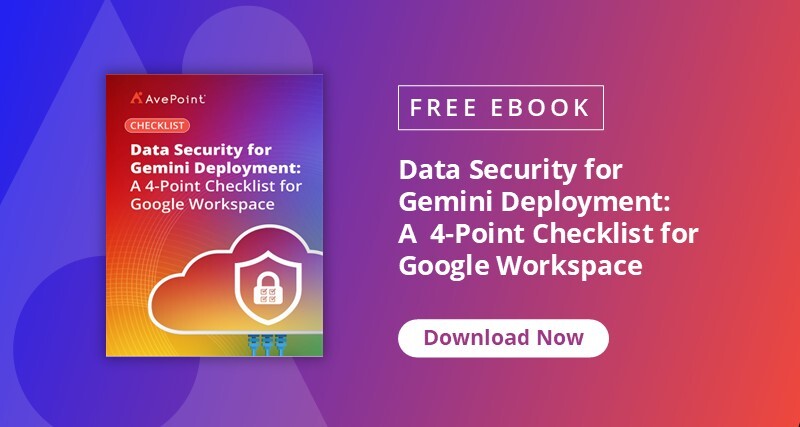We’ve spent the past two years getting comfortable with generative AI (GenAI) copilots: tools that assist, summarize, and suggest. However, enterprise AI does not end there. Google’s Gemini Enterprise (formerly known as Google Agentspace) is rewriting the operational blueprint rather than simply rolling out a new AI capability.
This shift is already underway. According to Microsoft's Work Trend Index Annual Report, about 82% of global leaders view 2025 as a turning point for re-evaluating core strategies and operational models. In addition, 81% expect AI agents to be moderately or extensively integrated into their company’s AI strategy within the next 12 to 18 months.
Gemini Enterprise introduces a new method for working in a multicloud environment, built for real-time responsiveness and scale. This signals the end of piecemeal productivity upgrades and the start of intelligent, AI-native workflows built for the future of work.
Agents Are Here and They’re Transforming How We Work
Gemini Enterprise is the enterprise-grade AI platform built by Google designed to deploy powerful AI agents throughout an organization. It deploys enterprise-grade AI agents across Gmail, Docs, Sheets, Drive, and third-party platforms. These agents don’t wait for user prompts. They run continuously and execute multistep workflows across systems.
Gemini Enterprise integrates with Workspace, BigQuery, and external platforms like Salesforce, Microsoft 365, and ServiceNow. AI agents coordinate people, data, and processes in intelligent, cross-functional flows. They retain context, adapt over time, and improve with every interaction.
For employees, this means relief from repetitive tasks and faster, more informed decisions. For leaders, it means rethinking workflows: shifting people toward design, governance, and ethical oversight, while AI agents handle execution.

From Assistant to Co-Worker: The Strategic Shift
Gemini Enterprise replaces entire swaths of tactical effort with autonomous, repeatable execution. It reflects a more profound transformation toward agentic AI, where machines respond to inputs and drive outcomes independently.
This raises an important question for enterprise leaders: When AI becomes your teammate, how do you define accountability?
Trust in human-machine collaboration marks a cultural change in the workforce. The organizations that will thrive are those that recalibrate how authority, oversight, and success are distributed across human and digital actors.
Here’s why that turning point matters:
Goal-Driven Autonomy
AI agents are assigned objectives, not micro-tasks. Instead of asking an agent to “send an email,” you assign it an outcome, like “update campaign budget based on performance,” and the agent builds and executes the workflow end-to-end.
Autonomous Decision Loops
AI agents continuously monitor live signals — emails, form inputs, and even performance data. They plan, act across platforms, and optimize their behavior based on analytics with no need for reset or human intervention.
Persistent Contextual Memory
AI agents retain context, unlike generative tools that start fresh with each query. Through Google’s “fleet” and observability model, they recognize patterns and improve across tasks.

Figure 1: The core architecture and workflow of Gemini Enterprise
How Gemini Enterprise Elevates Your AI Strategy
Gemini Enterprise is more than a platform; it's an operational catalyst. It points to where digital strategy must go next.
Gemini Enterprise elevates your AI strategy by enabling five critical capabilities that operationalize agentic AI to fit the organization’s requirements.
1. Facilitating Change from Orchestration to Autonomy
Most workflows today are still manual, siloed, or dependent on human escalation. Agents change that by automating decisions and taking action across business systems in real time.
In fact, half of tech executives foresee more than 50% of their AI deployment will be autonomous within two years, according to EY's survey. Gemini Enterprise accelerates this change by allowing teams to orchestrate multi-agent workflows across tools and platforms safely. Agents pull data, analyze context, and trigger actions – like routing tickets or updating records – without manual intervention.
2. Enabling Centralized Visibility for Smarter Governance
Enterprise intelligence is becoming distributed by design. Yet, most organizations lack visibility into where agents operate, what data they train on, and which decisions they influence. That’s a governance blind spot.
According to PwC, only 11% of U.S. executives have fully implemented responsible AI frameworks – including risk governance, monitoring, and transparency – even as adoption surges. Without clear oversight, agents can trigger policy violations, leak regulated data, or introduce untraceable decision drift in seconds.
Reducing risk starts with visibility. Gemini Enterprise centralizes visibility by surfacing active agents, data flows, and decision logs, enabling IT, risk teams, and business owners to govern through boundaries, not bottlenecks. With continuous observability baked in, Gemini Enterprise equips leaders to detect anomalies early, enforce compliance, and adapt guardrails in real time.
3. Transforming Data Architecture Into Strategic Infrastructure
A strong data foundation is non-negotiable for Gemini Enterprise to operate securely and autonomously. An IBM study found that while 61% of CEOs are deploying AI agents, half admit their tech ecosystems remain fragmented, largely due to accelerating adoption without integration discipline.
Gemini Enterprise requires unified mapping of user identities to apply permissions correctly across systems. This makes identity and access management a critical prerequisite. Misconfigured identities or disconnected systems can create serious exposure or breaches. Beyond secure access, agents depend on structured, interoperable, metadata-rich data. That data elevates system integration and governance from IT tasks to strategic infrastructure.
4. Augmenting Teams with Agent Networks
Organizations must now design for autonomous digital actors — AI agents that integrate seamlessly into teams, delivering persistent insight and always-on support across functions. However, without clear rules of engagement, they can disrupt trust, miss the mark, or duplicate effort.
Gemini Enterprise helps teams design escalation paths, role boundaries, and confidence thresholds. As such, agents act only where automation adds value and humans remain in control of the judgment calls that matter.
5. Enabling Adaptive Workflows That Scale with Change
Gemini Enterprise makes workflows more responsive by enabling agents to auto-adjust based on dynamic inputs. For example, agents can reroute service-level agreements (SLAs) based on customer urgency, reprioritize incident response based on threat levels, or escalate compliance risks as new data surfaces. Cross-functional issues in customer service, IT operations, and risk management demand speed and context for effective resolution.
This kind of responsiveness isn’t just theoretical: Forrester found that companies prioritizing responsiveness through agents resolved such issues 2.4x faster than those focused solely on efficiency.
Readiness Checklist: From Pilots to Platform Thinking
Across industries, agents are reshaping how operations flow. This is what that looks like:
In logistics and finance, they reassign deliveries using Maps and enterprise resource planning (ERP) data, flag anomalies, and accelerate reconciliation, without waiting for human input. In procurement, what once took hundreds of hours now runs as an autonomous sourcing loop. In compliance, agents surface potential violations before audits begin.
Most enterprises won’t deploy Gemini Enterprise overnight, but those who wait risk exposure, data gaps, and automation without guardrails.
Here’s what smart leaders are doing now to prepare:
- Start small. Identify one rules-based workflow to automate with an agent.
- Map interdependencies. Document where data lives, how it flows, and who governs it.
- Create a policy sandbox. Simulate agent behavior and permissions before scaling.
Agentic transformation starts with structure. Plan to scale and pilot wisely.
Gemini Enterprise Ushers in a New Operating Reality
Gemini Enterprise isn’t the final stop in enterprise digital transformation, but the first real test of AI-native operations.
The enterprise operating model is transitioning from static plans to continuous optimization. Real-time intelligence isn’t a layer — it’s the core.
- Agent networks will self-tune against live KPIs
- Humans will focus on oversight, system design, and governance
- Decision-making will flow closer to the data and not just the top-down hierarchy
This is where digital transformation breaks from waterfall projects and becomes a living, adaptive loop. The choices leaders make now – about data, policy, and organizational design – will define whether their business leads or lags in the agentic era.
Deploying Gemini Enterprise? Make sure Gemini-dependent data doesn’t become a blind spot through AvePoint’s four-point checklist to secure Gemini deployment.


